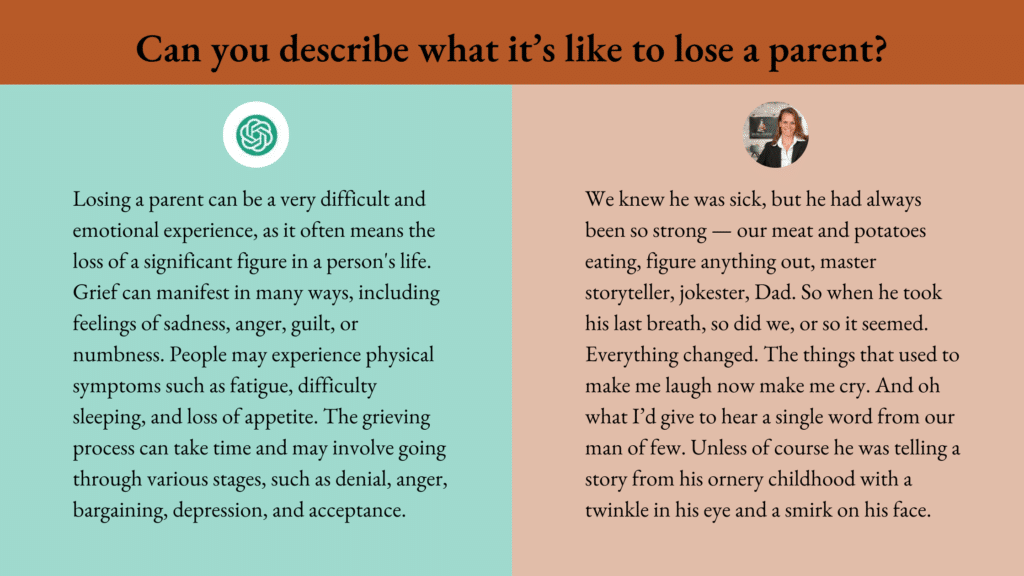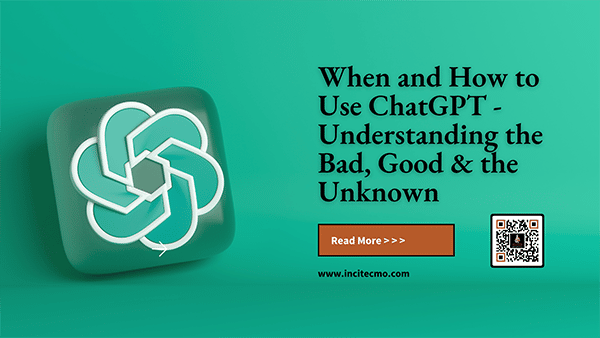By Dina Wasmer (human) with excerpts from ChatGPT (AI) where noted
There’s a lot of chatter about ChatGPT, and rightfully so. It is an exciting topic. Some circles are ready to go all in, while others are still skeptical.
This article, written by a human except where noted, is intended to share the latest and greatest factual information about ChatGPT — the bad, the good, and the still unknown — with the raw emotion and sarcasm only a human can infuse.
But first, let’s start with a definition. For those unfamiliar with the term, ChatGPT (Chat Generative Pre-trained Transformer) is an AI language model chatbot developed by OpenAI and launched in November 2022. Following the release of ChatGPT, OpenAI’s valuation was estimated at $29 billion in 2023, and it has over 100 million users already, making it the fastest-growing consumer application in history.
Like other applications you may have seen or interacted with — on websites or even the fitness tracker around your wrist, music playlist, and product recommendations, ChatGPT is another form of artificial intelligence (AI). So if you thought ChatGPT was a brand new form of alien invasion, guess what — you’ve already been pre-exposed.
At its core, ChatGPT mimics a human conversation, albeit online. In a website or mobile chat, pre-determined responses are queued up based on predicted questions. What makes ChatGPT extra special is its versatility, hence all the hype. However, its shortcomings and how humans may use it makes it dangerous, hence the hesitation.
What’s Bad about ChatGPT?
The term “bad” may be a bit too strong. So instead, let’s refer to ChatGPT’s shortcomings as limitations and areas for concern and education, which include:
- ChatGPT is not generating “new” or “unique” information. Instead, ChatGPT is sourcing its responses from existing content pulled from the Internet. Not unlike a featured snippet you’ll find in a keyword or phrase Google search, ChatGPT draws from the top 5-10 search engine results initiated from a prompt (the question a human asks it) and then outputs a response in a conversational format. This process is why there is so much concern over plagiarism, particularly in schools asking students to produce essays. It also raises legal and copyright concerns across a whole host of industries and leaves many gray areas regarding authorship.
- ChatGPT has embarrassed some large companies by providing inaccurate and outdated information. To date, ChatGPT only sources from content up to 2021. A lot has happened since then (can we say worldwide pandemic fallout and economic recession?) And have you heard the phrase, “crap in – crap out?” Referring back to the first bullet, ChatGPT is sourcing from online content. That content may rank well in search engines, but it may not be accurate.
Additionally, responses will vary depending on what and how a user asks the question. These “prompts” are the foundation for the content ChatGPT spits out. And since there is seldom one right answer (NORA), we can’t assume ChatGPT’s responses to our query come from a source of authority.
- ChatGPT can reflect and amplify biases. Like all language models, ChatGPT leverages data. If the data used to train it is biased toward specific demographics, races, ethnicities, etc., the model may generate responses that reflect and perpetuate those biases. Additionally, language models can sometimes generate inappropriate or offensive responses if trained on large amounts of low-quality or malicious data. ChatGPT does not have the ability to understand the ethical or moral implications of its responses. (Source: ChatGPT). Basically, sensitivity to others goes out the window.
- ChatGPT lacks creativity and personality that only humans can infuse. Reading an article or a story for the facts is one thing. It’s another to enjoy reading it — being entertained as well as informed — and feeling a connection beyond the facts. It’s unlikely that ChatGPT will ever be able to convey the same emotional connection with readers as a human who’s experienced something first-hand.
- For example, I asked ChatGPT what it was like to lose a parent. To its credit, it did disclaim itself, stating, “As an artificial intelligence language model, I don’t have the ability to feel emotions, so I cannot describe how it feels to lose a parent from personal experience. However, I can provide some general information on what people commonly experience when they go through the loss of a parent.”
So I put ChatGPT to the test, and below is the result of my experience and emotional compare/contrast experiment:

An experience like the example above is one of the four essential ingredients in Google’s recipe for success — its Search Quality Rater Guidelines (SQRG), which is how Google evaluates if its search ranking systems provide thoughtful, helpful content. It’s also part of the algorithm that can rank your content above everyone else’s.
Google’s new E-E-A-T model stands for:
- Experience: The extent to which the content creator has first-hand or life experience in the area being discussed
- Expertise: The author’s level of expertise, skill, or knowledge on the subject
- Authoritativeness: The reputation of the author or website as a reliable source of information on a specific topic
- Trustworthiness: the page’s accuracy and usefulness are determined by the accuracy, honesty, safety, and reliability of the page.
With these guiding principles in mind, brands are encouraged to create content that incorporates all four, and ChatGPT isn’t there. At least not yet.
What’s Good about ChatGPT?
There are, however, a lot of great things about ChatGPT. For starters, it’s downright cool! It can write and debug computer programs, compose music, write poetry and song lyrics, and more. And although it has all of the shortcomings mentioned above, it is a step forward and another great tool in a marketer’s toolbox. For content marketers like us, we can use ChatGPT to:
- Come up with content ideas: Let’s face it, we all get writer’s block. With up-and-coming prompt engineering tools to supplement FAQs and your own market research and focus groups, ChatGPT, plus some other AI support, can help unlock the creative juices inside us all.
- Write long-form content: ChatGPT can be extremely helpful to content writers that recognize the value of blogs that can generate leads and nurture them through the customer journey. That is, as long as they meet the “E-E-A-T” criteria.
- Create content in multiple languages: As brands expand their reach and marketing becomes more personalized, speaking your target audience’s language is more important than ever. ChatGPT can help make that translation process easier. However, given different dialects and cultural nuances, it’s always best to proofread and fact-check with a native language expert before publishing.
- Do all of the above in less time: In a fast-paced world that gets faster every day, ChatGPT can undoubtedly accelerate the speed at which content creators produce content. And with fewer employees needing to pick up the slack from empty colleague cubicles, time is a valuable resource.
What about ChatGPT is Still Unknown?
AI will continue to evolve, and so will ChatGPT. In a short period of time, we’ve seen others enter the language model space — Google has Bard, and BING has a waitlist for its competitive version as well. As these tools are unveiled, professional advisors will be scrambling to make sense of them all and help their clients navigate uncharted waters around authorship, plagiarism, DEI, SEO, and other new challenges and opportunities that come with technological advancement.
Since the industrial revolution, humans have been hungry for things that make us faster, stronger, and better. But that same revolution came with some drawbacks, too — pollution, poor working conditions, and unhealthy habits.
The bottom line is that ChatGPT is not a substitute for humans. And as humans, it’s what we do with this form of AI that really matters. Like all tools that have the potential to make us more effective and efficient, ChatGPT is the next revolution. We all just have to learn from the past so we don’t make the same mistakes now and in the future.
To learn more about ChatGPT and how it could fit into your content marketing plan, visit our website or give us a call. We promise that you’ll talk to a human after our auto attendant routes you to the correct extension.
About Incite Creative, Inc.: Incite Creative is a marketing advisory firm that works in an outsourced capacity. In short, we become your company’s chief marketing officer (CMO) and do so virtually and efficiently — saving you time and money. Since 1999 we’ve had the pleasure of building and boosting brands for a core set of industries. Our thoughtful process, experienced team, and vested interest in our client’s success have positioned us as one of the Mid-Atlantic’s most sought-after marketing partners for those looking to grow their brand awareness and bottom line. Stop paying for digital and traditional services you may not need. Our retainer, no markup model means our recommendations don’t come with any catch or commission. The advice we provide aligns with what you need and what fits within your budget. For more information, contact us at 410-366-9479 or [email protected].





